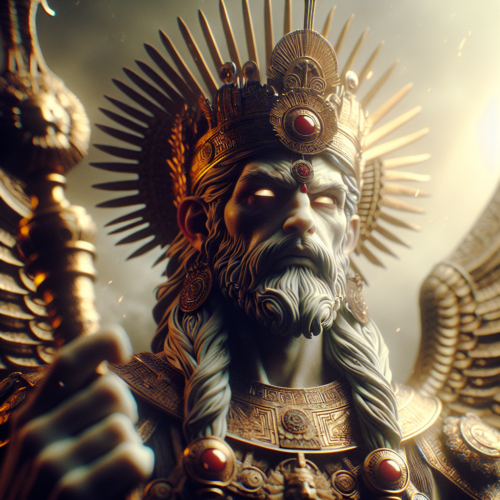Enlil, known as the “Lord of the Wind,” is the god of air in Mesopotamian mythology. He commands immense respect and authority within the pantheon of gods. His name, composed of the Sumerian words “EN” meaning “lord” and “LIL” meaning “air,” reflects his dominion over the elements of the sky.
Enlil’s can summon nurturing breezes and catastrophic storms, both seen as expressions of his voice or breath. Therefore, it is clear that he could strongly influence agriculture and life itself. Myths recount how Enlil separated the heavens from the earth, thereby creating space for plants to grow. And with the creation of the plow, he pierced the earth’s crust for the first seeds to be planted in the soil
Within the divine order, Enlil was part of an influential triad with Anu and Enki. Although Anu was positioned at the apex of the Mesopotamian pantheon, Enlil was more central. He symbolized vigor, might, and command.
Ninlil, the goddess of grain and fertility, was his wife. Their children were were Nanna, Nergal, Ninazu, and Enbilulu.

Symbolism
Depicted as a dignified figure with a beard, Enlil was often portrayed wearing a horned headdress, a divine emblem common among the gods from the third millennium BC. This headdress, with its stacked ox-horns, was a consistent emblem of divinity that persisted until the era of the Persian Empire’s dominance.
Enlil’s mythos is filled with accounts of his formidable power and his crucial function in the universe. He was once the keeper of the Tablets of Destiny, which endowed him with the power to determine the universe’s and humanity’s destinies. He could be a benevolent ruler, but let’s not forget that he tried to wipe out humankind at some point.
Myths in which Enlil makes an appearance
- Enlil’s invention of the plow
- Atrahasis
- Enuma Elish
- The Tablet of destinies: sometimes it’s Enlil, sometimes it’s Enki. We chose to use Enki in this story.
Modern appearances
Books
- “The Book of Enlil” by Stephen C. Norton
Movies and TV series
- “Anunnaki” (2014)
- “Anunnaki Nephilim: The Return”
